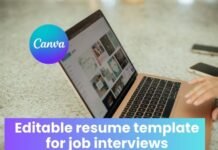Last Updated on October 15, 2025
When it comes to job applications, your resume is often the first impression an employer gets of you. A well-written resume is not just about listing your qualifications—it’s about presenting them in a clear, structured, and professional format. Hiring managers typically spend only a few seconds scanning a resume, which means that formatting can make the difference between getting noticed or getting overlooked.
Resume formatting is more than just choosing a font or margin size; it’s about creating a layout that highlights your skills, experience, and achievements in the most effective way possible. With Applicant Tracking Systems (ATS) becoming increasingly common, the correct format also ensures that your resume passes through digital filters and lands in the hands of a recruiter.
In this guide, we will explore the most popular resume formats, discuss when each is most effective, and provide detailed tips on how to format a resume correctly. By the end, you’ll have a clear understanding of how to present your professional history in a way that maximizes your chances of landing interviews.
What are the most popular resume formats?
There are three primary resume formats that dominate the job market:
- Chronological Resume Format – Highlights work experience in reverse chronological order.
- Functional Resume Format – Focuses on skills and abilities rather than employment history.
- Combination Resume Format – Merges elements of both chronological and functional structures.
Each of these formats serves a specific purpose depending on the applicant’s career stage, background, and job target. While chronological resumes remain the most widely used, functional and combination formats can be advantageous for candidates with non-traditional career paths or unique skill sets.
In addition to these, other less common formats—such as creative resumes for design fields or targeted resumes for niche roles—may also be worth considering. Choosing the right format is critical because it determines how effectively your qualifications are communicated to recruiters and hiring managers.
Chronological Resume Format
The chronological resume format is the most traditional and widely accepted style. It lists work history in reverse chronological order, starting with your most recent position and working backward. This format emphasizes steady career growth and a clear timeline of employment.
Key Features of a Chronological Resume:
- Employment history listed from most recent to oldest
- Focus on job titles, companies, and dates of employment
- Detailed description of responsibilities and achievements under each role
- Clear career progression highlighted through promotions or increasing responsibilities
This format is especially beneficial for professionals with a consistent career path, as it showcases stability and growth in a specific field. It also aligns well with ATS software, which often prioritizes chronological structures.
When to use a chronological resume
A chronological resume is ideal if:
- You have a strong, consistent work history in the same industry
- You want to highlight progressive career development
- You are applying to traditional industries such as business, healthcare, or education
- Your recent job experience closely matches the role you’re applying for
On the other hand, this format may not be suitable for individuals with significant employment gaps, frequent job changes, or those transitioning into a completely new career path. In such cases, another format may serve you better.
Functional Resume Format
The functional resume format shifts attention away from job titles and timelines, instead placing emphasis on skills, qualifications, and accomplishments. Instead of presenting your career history in chronological order, this format organizes information by specific areas of expertise.
Key Features of a Functional Resume:
- Skills and abilities are grouped into categories such as Leadership, Communication, Technical Proficiency, or Project Management.
- Each skill section includes examples or short descriptions of how you applied those skills.
- Employment history is listed at the bottom in a brief section, usually without detailed descriptions.
- Greater focus on what you can do, rather than where or when you did it.
Because it highlights competencies rather than job history, the functional resume is particularly effective for candidates whose backgrounds don’t follow a linear career path. It allows applicants to showcase their strengths even if they lack direct experience in a particular industry.
When to use a functional resume
The functional format is not for everyone, but it can be very powerful in specific situations. You should consider using this style if:
- You are changing careers and need to emphasize transferable skills instead of unrelated job titles.
- You have significant gaps in your employment history and want to minimize the attention given to dates.
- You have a diverse background with various short-term projects, freelance roles, or self-employment.
- You are a recent graduate who may not yet have a long track record of professional roles but has relevant coursework, internships, or volunteer experience to highlight.
However, there are some drawbacks. Many recruiters and hiring managers prefer the chronological format because it is easier to track a candidate’s career progression. Additionally, some Applicant Tracking Systems (ATS) may struggle to interpret functional resumes, which could reduce visibility.
For this reason, while a functional resume can be an excellent option for career changers or non-traditional candidates, it’s important to tailor it carefully to ensure clarity and ATS compatibility.
Combination Resume Format
The combination resume format (also called a hybrid resume) blends elements of both chronological and functional structures. It allows you to highlight your skills while also presenting a clear employment history. This makes it one of the most flexible and versatile resume styles available.
Key Features of a Combination Resume:
- Begins with a summary or skills section that highlights core strengths and expertise.
- Follows with a chronological list of professional experience, starting with the most recent role.
- Provides room to showcase both accomplishments and a clear work timeline.
- Balances skills and experience equally, making it easier for employers to see your qualifications at a glance.
This format is often seen as the best of both worlds. It’s especially useful when you want to emphasize transferable skills while also showing a consistent employment history.
When to use a combination resume
The combination format is best suited for candidates who:
- Have strong skills and accomplishments they want to showcase immediately.
- Possess a stable work history but also need to highlight specific expertise that aligns with the role.
- Are transitioning into a new industry but still want to demonstrate relevant past experience.
- Work in industries that value both technical abilities and a proven career timeline, such as IT, marketing, or project management.
For example, if you’re a software developer applying for a project management role, the combination resume allows you to highlight your leadership and organizational skills while still showcasing your technical background. Similarly, mid-level professionals moving into senior roles often benefit from this format because it highlights their growth and specialized skills simultaneously.
One potential drawback is that combination resumes can become lengthy if not managed carefully. Since they include both skill sections and detailed work history, candidates must remain concise and prioritize only the most relevant information.
Other Resume Formats to Consider
While chronological, functional, and combination resumes are the most common, there are several other formats worth considering depending on your profession and job target.
- Targeted Resume – Customized specifically for a single job posting, focusing only on skills and experiences directly relevant to that position. This format requires more effort but often yields higher success rates.
- Creative Resume – Common in design, marketing, or media industries, these resumes may include visuals, graphics, or non-traditional layouts to showcase creativity. However, they should be used cautiously since ATS software may not process them well.
- Mini Resume – A condensed version of your resume, often used for networking events, business cards, or LinkedIn summaries. It highlights only your key qualifications and achievements.
- Federal Resume – Required for U.S. government jobs, this format is far more detailed than a standard resume and includes sections like citizenship status, security clearance, and specialized job codes.
Each of these formats serves a unique purpose. The right choice depends on your industry, the specific role you’re applying for, and whether your resume will be scanned by an ATS before reaching human recruiters.
How to Format a Resume
Choosing the right structure is only half the battle. Proper formatting ensures your resume looks professional, is easy to read, and gets through digital scanning systems without errors. Below are seven essential formatting guidelines:
1. Apply appropriate margins
Set your resume margins between 0.5 and 1 inch on all sides. Narrow margins give you more space to fit content, while wider margins improve readability. A balance ensures your resume looks clean without appearing overcrowded.
2. Select a professional, readable font
Stick with fonts that are simple, modern, and ATS-friendly. Popular choices include Arial, Calibri, Helvetica, and Times New Roman. Decorative or script fonts should be avoided, as they can appear unprofessional and may not display properly in ATS systems.
3. Make your font size 10 to 12 points
The body text should be between 10–12 points, while section headers can be slightly larger (14–16 points). Consistency is key; using too many font sizes creates visual clutter.
4. Make your ideas concise
Recruiters scan resumes quickly. Avoid long paragraphs and unnecessary words. Each bullet or sentence should highlight a measurable achievement or skill. For example: “Increased sales by 25% within one year by implementing a new customer retention strategy.”
5. Feature section headers
Clearly labeled sections—Summary, Work Experience, Skills, Education—make it easier for both humans and ATS software to navigate your resume. Use bold text or slightly larger font sizes for headers, but avoid excessive colors or graphics.
6. Use bullet points where appropriate
Bullet points break up large chunks of text and draw attention to accomplishments. Limit each role to 3–6 bullet points, focusing on achievements rather than basic duties. For example: instead of “Responsible for team meetings,” write “Led weekly team meetings to streamline project timelines and improve communication across departments.”
7. Ask for feedback
Before submitting your resume, ask a trusted colleague, mentor, or career coach to review it. Fresh eyes often catch errors you might overlook. Feedback also helps ensure that your resume communicates the right message to potential employers.
Resume Format Examples
Understanding resume formats in theory is useful, but seeing how they look in practice provides a clearer picture. Below are simplified examples of the three most common formats. These are not full resumes, but structured outlines to show how information is typically arranged.
Chronological Resume Example
Name
[Phone Number] | [Email Address] | [LinkedIn Profile]
Professional Summary
Results-driven marketing professional with 8+ years of experience in digital campaigns, brand strategy, and team leadership. Proven ability to increase engagement and drive revenue growth.
Work Experience
Senior Marketing Manager – XYZ Company | 2020–Present
- Developed and executed digital campaigns that boosted sales by 30% within 12 months.
- Managed a team of 10 marketing associates, improving productivity by 20%.
Marketing Specialist – ABC Agency | 2016–2020
- Coordinated multi-channel campaigns for Fortune 500 clients.
- Increased client retention rate by 15% through personalized strategy.
Education
Bachelor of Business Administration – University of California
Skills
Digital Marketing | SEO | Content Strategy | Leadership | Data Analytics
Functional Resume Example
Name
[Phone Number] | [Email Address] | [Portfolio/Website]
Professional Summary
Creative professional with strong expertise in project management, communication, and design. Skilled in managing multiple projects, coordinating teams, and delivering high-quality results.
Key Skills & Achievements
Project Management
- Oversaw multiple cross-functional projects with budgets exceeding $500K.
- Implemented new workflow systems that reduced project delays by 25%.
Communication & Collaboration
- Facilitated client presentations and negotiations that secured long-term contracts.
- Trained new employees on team collaboration tools.
Design & Creativity
- Designed visual marketing campaigns that increased engagement by 40%.
- Produced multimedia content that won two industry awards.
Work History
Freelance Project Coordinator – 2019–Present
Customer Support Representative, Tech Solutions – 2016–2019
Education
Bachelor of Arts in Communications – New York University
Combination Resume Example
Name
[Phone Number] | [Email Address] | [LinkedIn Profile]
Professional Summary
IT professional with 7+ years of experience in software development and team leadership. Adept at coding, system optimization, and mentoring junior developers.
Key Skills
- Programming: Java, Python, SQL
- Project Management: Agile, Scrum
- Leadership: Mentorship, Team Collaboration
Professional Experience
Software Engineer Lead – Innovatech Solutions | 2019–Present
- Directed a team of 6 developers to deliver high-quality software ahead of schedule.
- Reduced system downtime by 40% through process improvements.
Software Developer – BrightApps Inc. | 2015–2019
- Built and maintained mobile applications downloaded by 100K+ users.
- Collaborated with cross-functional teams to enhance app features.
Education
Bachelor of Science in Computer Science – Stanford University
Frequently Asked Questions
1. Which resume format is best for most job seekers?
The chronological resume format is generally the most widely accepted and preferred by recruiters. It provides a clear work history and shows career growth over time. However, career changers or those with gaps in employment may benefit more from functional or combination resumes.
2. Can I use a creative resume format?
Yes, but only if you are in a creative field such as graphic design, marketing, or media. For traditional industries like finance, healthcare, or law, a creative resume may appear unprofessional and may not pass through Applicant Tracking Systems (ATS). Always check the employer’s culture before submitting one.
3. How long should my resume be?
For most job seekers, a one-page resume is ideal, especially for entry-level positions. Mid-level or senior professionals with extensive experience may extend to two pages. Anything beyond that is rarely necessary unless applying for academic, federal, or research positions.
4. Should I include references on my resume?
No, it’s not necessary to list references directly on your resume. Instead, prepare a separate reference sheet that can be provided upon request. Use that valuable space to highlight your skills and achievements.
5. What file format should I submit my resume in?
PDF is usually the safest choice because it preserves formatting across devices. However, some employers require Word documents (.docx) for ATS compatibility. Always follow the employer’s application instructions.
6. How do I make sure my resume passes ATS scans?
Use simple, professional fonts.
Avoid images, graphics, and unusual layouts.
Use clear section headers like Work Experience, Skills, Education.
Include keywords from the job description naturally throughout your resume.
7. Is it okay to tailor my resume for each job?
Yes—tailoring your resume to match each job posting greatly improves your chances of landing interviews. Adjust your skills, achievements, and keywords so they align closely with the role you are applying for.
8. Can I mix different formats?
Yes, and that’s essentially what a combination resume does. However, avoid making the structure too complicated. Clarity and readability should always be the top priority.
9. What’s the biggest formatting mistake job seekers make?
The most common mistakes include using overly decorative fonts, cluttered layouts, inconsistent spacing, and failing to highlight achievements. A resume should be easy to scan in 10–15 seconds.
10. Should I include my photo on a resume?
In most countries, no. Including a photo can lead to unintentional bias and is discouraged unless specifically requested. Exceptions exist in certain industries (e.g., acting, modeling) or regions where photos are standard.
Final Thoughts
A well-formatted resume is more than just a document—it’s your personal marketing tool. By choosing the right format and following best practices, you can present your skills, experience, and accomplishments in a way that captures a recruiter’s attention.
Whether you use a chronological, functional, or combination format, remember that clarity, professionalism, and relevance are key. Combine strong content with proper formatting, and you’ll significantly improve your chances of landing interviews and advancing in your career.

